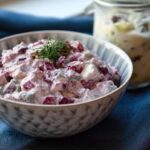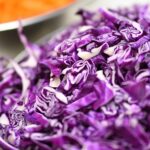
Tangy, creamy, and full of flavor – Heringssalat, or German herring salad, is a traditional dish especially popular during festive seasons like Christmas, New Year’s, and Karneval. Combining marinated herring with apples, beets, onions, and a creamy dressing, this vibrant salad offers a perfect balance of sweet, sour, and savory.
It’s more than just a dish – it’s a celebration of old-world preservation methods and bold flavors that still grace modern German tables.
The Origins of Heringssalat Recipe
Heringssalat dates back centuries and reflects Germany’s long-standing tradition of preserving fish. Pickled or marinated herring was a staple in coastal and inland households alike, offering reliable protein through the winter months.
Over time, the dish evolved from a simple fish salad into a colorful, celebratory meal. In Northern Germany and along the Baltic coast, Heringssalat is a common feature of New Year’s Eve buffets, believed to bring good luck. In Catholic regions, it’s often enjoyed on Ash Wednesday, marking the beginning of Lent.
Its bold flavor and dramatic color – usually a result of red beetroot – make it a standout at any cold buffet. For more traditional side dishes and seasonal classics, visit our German Salad Recipes page.
Ingredients for Authentic Heringssalat Recipe
- 250 g pickled herring fillets (Matjes or Bismarck-style)
- 1 medium apple, peeled and diced
- 1 small onion, finely chopped
- 1 medium cooked beetroot, peeled and diced (or canned beets)
- 2–3 medium boiled potatoes, peeled and diced
- 2 pickles (gherkins), finely chopped
- 100 ml sour cream
- 100 ml plain yogurt or mayonnaise (or a mix)
- 1 tablespoon vinegar (white wine or pickle vinegar)
- 1 teaspoon mustard
- Salt and pepper to taste
- Optional garnish: chopped dill or parsley
Kitchen Tools You’ll Need:
- Sharp knife
- Mixing bowl
- Spoon or spatula
- Cutting board
How to Make Heringssalat Recipe (Step-by-Step Instructions)
Step 1: Prepare the Ingredients
Dice the herring, apple, beetroot, onion, potatoes, and pickles into bite-sized pieces. Set aside in separate piles for ease.
Step 2: Make the Dressing
In a large bowl, combine the sour cream, yogurt or mayo, vinegar, and mustard. Whisk until smooth. Season with salt and pepper.
Step 3: Combine and Mix
Add all the prepped ingredients into the bowl with the dressing. Stir gently to coat everything evenly. Beets will begin to color the dressing, turning it a soft pink – this is traditional and part of the appeal.
Step 4: Chill and Rest
Cover the salad and refrigerate for at least 2 hours, or ideally overnight. The flavors develop beautifully with time.
Step 5: Garnish and Serve
Before serving, taste and adjust the seasoning. Garnish with fresh chopped dill or parsley if desired.
How to Serve Heringssalat
Heringssalat is most commonly served cold, either as a starter, part of a festive buffet, or even as a main course during Lent or New Year’s. It pairs well with Bratkartoffeln (Fried Potatoes), rye bread, or a rustic roll.
During the holiday season, it’s often served alongside Eiersalat (Egg Salad), Rote-Bete-Salat (Beetroot Salad), and Kartoffelsalat as part of a cold meal spread.
It also pairs well with a crisp German pilsner or a glass of chilled schnapps during festive meals.
Variations and Regional Twists
Matjessalat (Matjes Herring Salad):
Uses younger, milder herring fillets and usually omits beetroot. The dressing is often made with apples, sour cream, and onion only.
With Boiled Eggs:
Some families add chopped boiled eggs to make the salad even richer and more filling.
With Horseradish:
Adding a spoonful of grated horseradish to the dressing gives the salad a spicy kick – popular in Central and Eastern German variants.
With Apple Cider Vinegar:
Enhances the fruity notes and complements the apple beautifully.
Heringssalat is a bold, vibrant, and festive salad that captures both the practicality and celebratory nature of German cuisine. Whether you serve it during the holidays or as a midweek treat, it’s a dish that delivers complex flavor with minimal effort.
Give this timeless recipe a try, and discover how preserved fish and simple vegetables can turn into something truly special. For more traditional inspiration, explore Matjessalat, Wurstsalat, or the full archive of German Salad Recipes.







